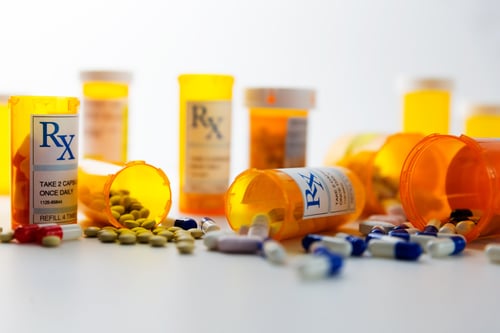

Overmedication of America: Prescription Drug Use on the Rise
Americans' use of prescription drugs has skyrocketed in the last decade as about 2 in 3 U.S. adults increasingly take advantage of the 20,000+ prescription drugs approved for marketing.
“The number of prescriptions dispensed in the U.S. has increased between 2009 and 2021. In 2009 the number of prescriptions dispensed was nearly 3.95 billion, while in 2021 the number of prescriptions dispensed was around 6.47 billion,” reports Statista. “The increase in the number of prescriptions dispensed has a multifactorial origin that includes health care sources, health insurance, and prescription drug benefits. However, the increase in prescription drug usage comes with a price tag as the price of drugs in the U.S. is also on the rise.”
Statista estimates that U.S. prescribed drug expenditures amounted to $360 billion in 2020, and those costs are projected to continue to soar as “the total number of retail prescriptions filled annually in the United States is expected to also rise significantly by the year 2025.”
The overmedication of America is a problem that has been building with the University of Illinois Urbana-Champaign reporting back in 2013 that physicians were receiving special training to learn how to “just say no” to patients” demanding prescriptions.
“They spoke of physicians actually needing to take refusal skills. It has become that pressured,” said national medical conference attendee Martha Rosenberg. “Many doctors want to be liked, and they want their patients to return, so they don’t want to say no.”
Daily Habit: Americans and Prescription Medication
From opioids to antibiotics, American medicine cabinets are overflowing with prescription bottles according to the latest data from the Centers for Disease Control and Prevention (CDC).
The CDC report on prescription drug use in the past 30 days for 2015 to 2018 found that not only did half of Americans take one prescription drug in the past month, but that 1 in 4 were taking 3 or more prescription drugs, and 1 in 10 were using 5 or more prescription drugs.
These numbers were up, some significantly from comparative reporting periods dating back to the late 1980s:
- Percent of persons using at least one prescription drug in the past 30 days:
o 2015-2018: 48.6 percent
o 1988-1994: 37.8 percent
- Percent of persons using three or more prescription drugs in the past 30 days:
o 2015-2018: 24 percent
o 1988-1994: 11 percent
- Percent of persons using five or more prescription drugs in the past 30 days:
o 2015-2018: 12.8 percent
o 1988-1994: 3.6 percent
The quadrupling of those taking 5 or more prescription drugs falls under the category of polypharmacy, defined as regular use of at least five medications.
Polypharmacy Can Lead to Adverse Drug Events
Polypharmacy is a common issue in long-term care (LTC) environments where a Cleveland Clinic Journal of Medicine paper in 2018 estimated that up to 74 percent of patients in skilled nursing facilities and LTC take nine medications or more.
“There is supporting data from pharmaceutical-care principals that, on average, patients taking five medications will average one significant drug problem,” said a paper published in the Mayo Clinic Proceedings. “What remains clear is that higher numbers of medications increase the frequency of adverse drug events (ADEs), nonadherence, and costs.”
Polypharmacy is not limited to LTC settings as typical visits to local emergency room departments can result in a clutch of prescriptions.
The National Ambulatory Medical Care Survey 2018 found that 79.5 percent of the estimated 336b million annual hospital emergency department visits resulted in drug therapy.
Almost 40 percent of those ER visits resulted in 3 or more medications and more than 1 in 10 checked out with 6 or more medications.
According to the survey, medication therapy and the number of medications mentioned at emergency department visits:
- O medication: 20.5 percent
- 1 medication: 21.6 percent
- 2 medications: 18.5 percent
- 3 medications: 13.7 percent
- 4 medications: 9.4 percent
- 5 medications: 5.7 percent
- 6 medications: 3.6 percent
- 7 medications: 2.1 percent
- 8 medications: 1.4 percent
- 9 or more medications: 3.7 percent
Visits to physician offices resulted in just slightly less medication with 68.7 percent of the estimated 860.4 million annual visits resulting in drug therapy.
Antibiotic Overuse: Stopping the Superbugs
Some of the most common drugs prescribed in the emergency room visits were antibiotics such as:
- Cephalexin
- Ceftriaxone
- Azithromycin
- Amoxicillin
While much of the current overmedication focus is rightly on the opioid epidemic, with the 2019 National Survey on Drug Use and Health estimating that some 10.1 million people misused prescription opioids in the past year and 70,630 died from a drug overdose, there is also a concern on the increasing reliance on antibiotics.
Highly resistant microbes or “superbugs” are becoming increasingly common as many physicians encounter antimicrobial resistance in their everyday practices.
Arkstone Medical Solutions, a biomedical technology company that uses artificial intelligence and machine learning, estimates that the global threat due to antimicrobial resistance includes:
- 700,000 worldwide annual deaths due to antimicrobial resistance
- 50 percent of outpatient antibiotic prescriptions are unnecessary or inappropriate
- $20 billion estimated additional cost to the U.S. healthcare system each year
“Antibiotic resistance has the potential to affect people at any stage of life, as well as the healthcare, veterinary, and agriculture industries. This makes it one of the world’s most urgent public health problems,” says the CDC 2019 Antibiotic Resistance Threats Report.
How to Stay Safe from Overmedication
Modern medication obviously plays a central role in increasing our quality of life, but overmedication can happen, according to Premier Health, when doctors, specialists, hospital physicians, and pharmacists don’t pay attention to the drugs patients are already taking before describing something new.
“The problem is especially prevalent among the elderly. In a study at the UCLA Santa Monica Medical Center, researchers found that geriatric patients, on average, were taking 14 different medications. In some instances, the result can be life-threatening,” says Premier Health.
4 steps that patients can take to stay safe from overmedication include:
- Make a List and Check it Twice! Patients should keep a list of every medication they take (including frequency and dosage), including all prescriptions, over-the-counter medication, and even vitamins. This list should be reviewed with your personal physician and pharmacist at every visit.
- Ask the Right Questions: Premier Health says that patients should ask their doctor at each visit the following questions:
o Am I taking the proper dosage of the medication?
o What should I do if I miss a dose?
o Do I need to take the medication with food and/or water?
o Under what conditions can I lower the dose or stop taking the medication?
o Are there other remedies available to treat my problem besides medication?
- Know the Danger Signs of Overmedication: Contact your doctor if you notice any of the following signs of overmedication:
o Drowsiness
o Dry mouth and ulcers
o Confusion
o Hallucinations
o Dizziness or falls
o Seizures
o Behavior changes such as withdrawal from family and friends
- Understand Risks of Antipsychotic Drugs: Premier Health says that LTC facilities will often treat residents with antipsychotic drugs to help with anxiety or agitation associated with dementia, but that these serious drugs can have life-threatening side effects. Patients and their caregivers should weigh the pros and cons of using antipsychotic drugs carefully.
“The twentieth century witnessed miracles in terms of improved health and greater longevity, and certainly one of the factors in that sea change has been advances in pharmaceuticals and pharmacotherapeutics. With the advent of antibiotics, steroids, antihypertensives, statins, and life-saving medications for diabetes, people are living longer with fewer symptoms and, in general, better quality of life,” says Health Affairs. “Despite all the benefits of modern medications, excess prescribing is putting millions of older people at grave risk of harm. The vast majority of drugs are prescribed by clinicians with the best of intentions, and for many people with multiple chronic illnesses, several drugs may be needed. However, every additional drug increases the risk of harm.”
Subscribe to email updates
Related Articles

Topics

Topics

Topics



